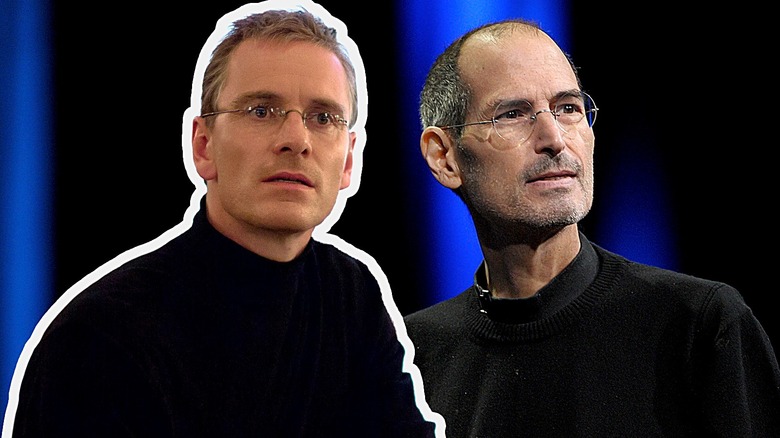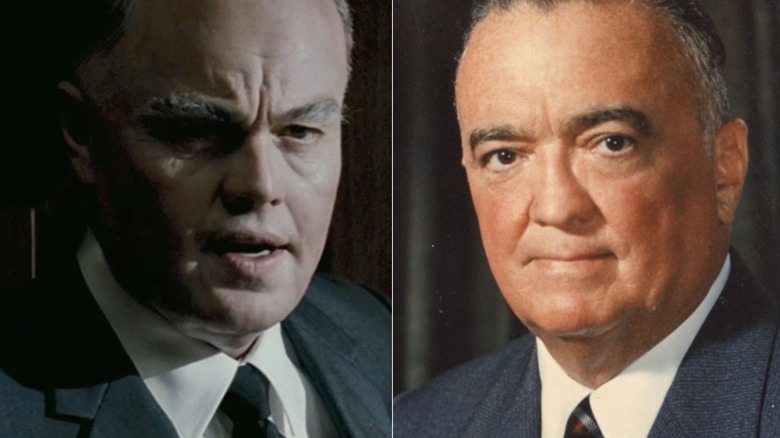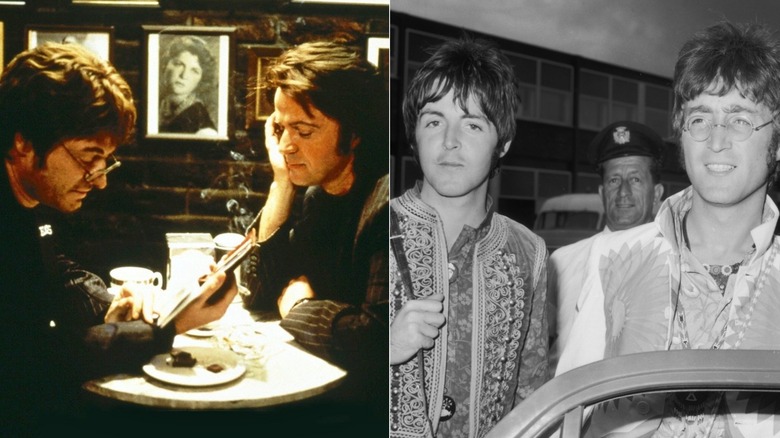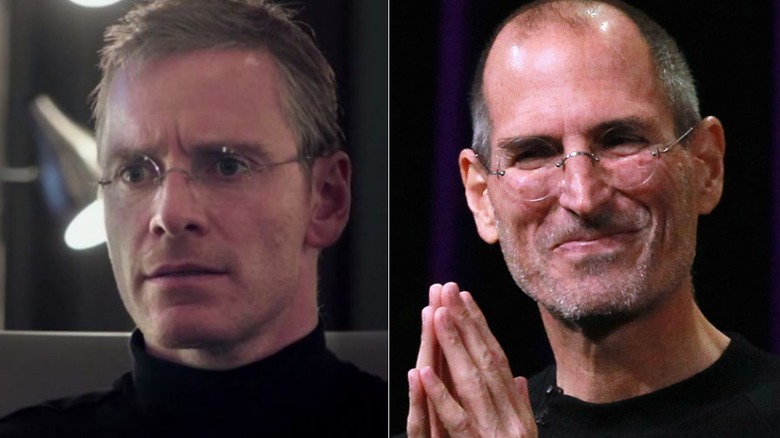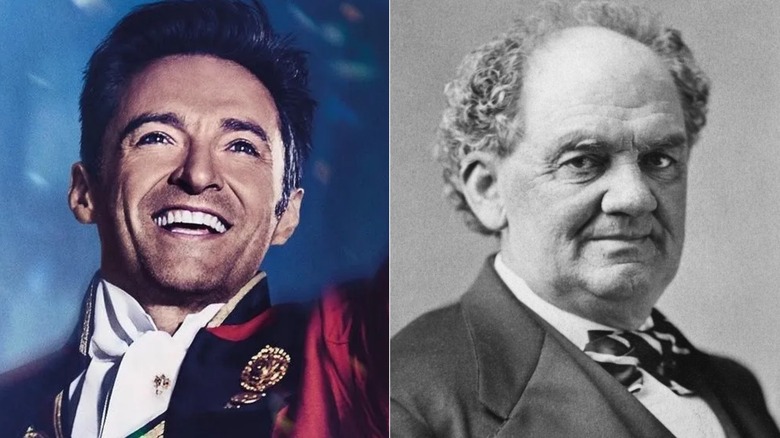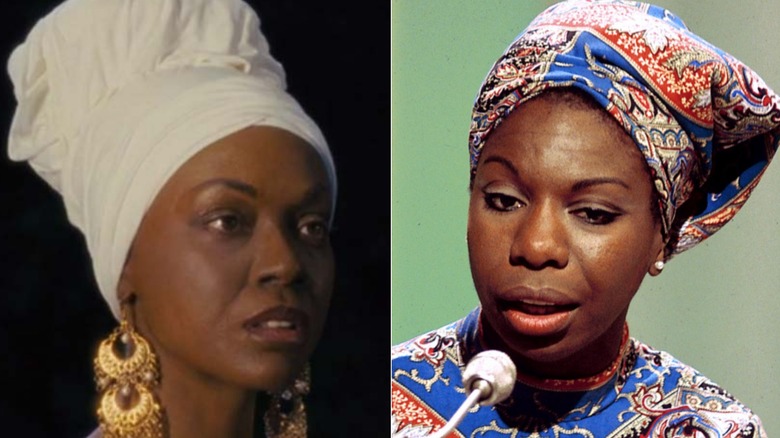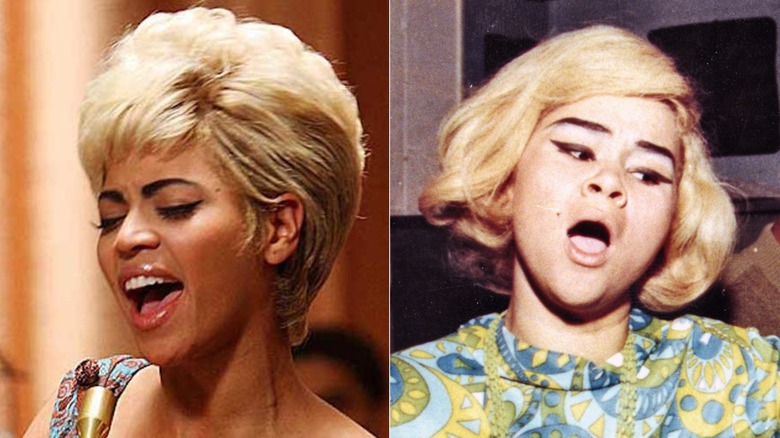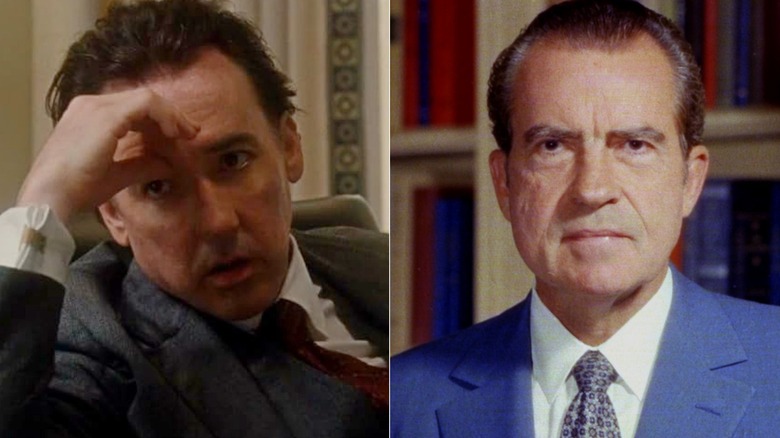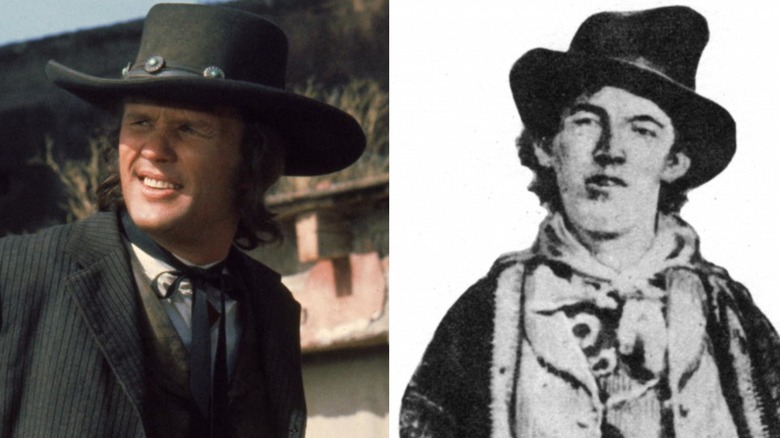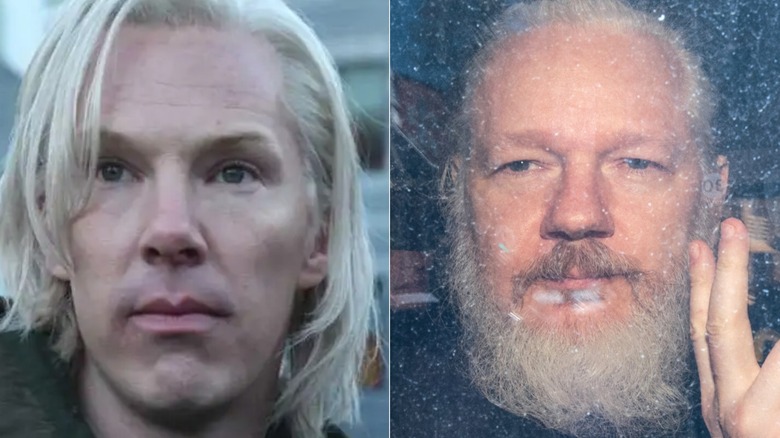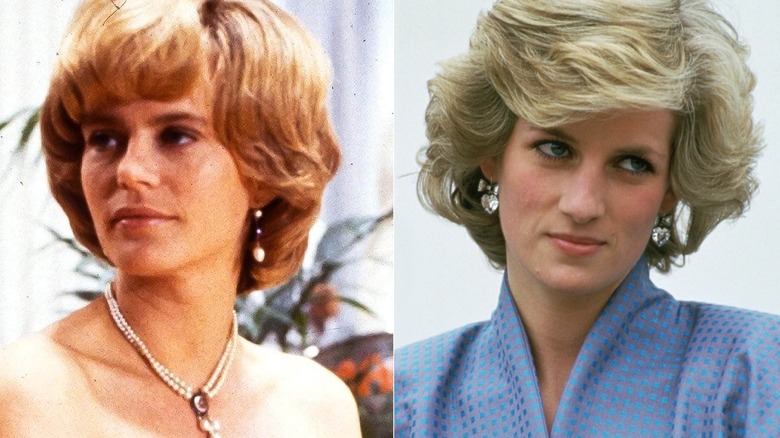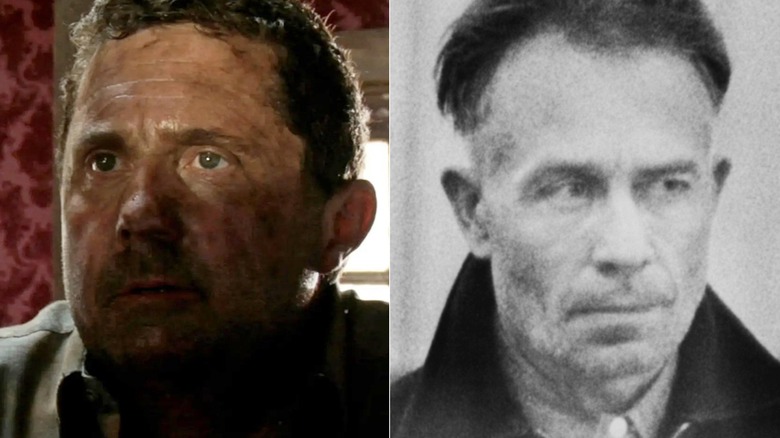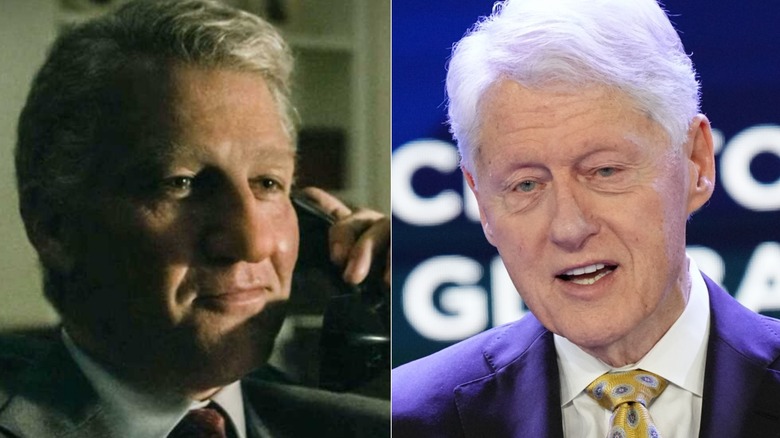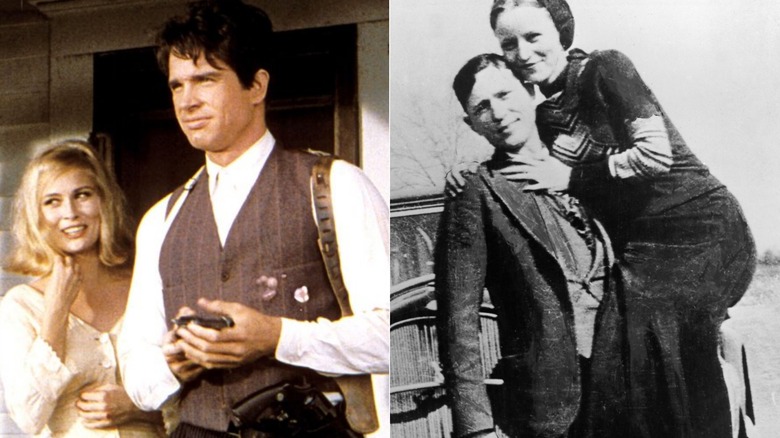Actors Who Look Nothing Like The Real-Life Figures They Played
Biopics — movies based on the lives of real figures from history and culture — have been a cinema staple since the invention of motion pictures. One of the earliest films ever made, "The Execution of Mary Stuart," directed by Thomas Edison in 1895, depicts the death of Mary, Queen of Scots in 1587. The next century of filmmaking saw studios release countless biographical films, many of which are now considered classics: "Young Mr. Lincoln," "Gandhi," "The Last Emperor," "Ray," — the list goes on and on.
In many of these and other cases, filmmakers found actors who could not only transform themselves performance-wise into these famous figures but also bore an uncanny resemblance to them. Notable examples include Sir Ben Kingsley in "Gandhi," Val Kilmer in "The Doors," and more recently, Cillian Murphy in "Oppenheimer." And then there are those actors who looked nothing like the celebrated people they played. Following is a list of actors who were anything but exact doubles of the real-life figures they played in films and on TV.
Leonardo DiCaprio as J. Edgar Hoover (J. Edgar)
Leonardo DiCaprio has portrayed more than his share of real-life figures in motion pictures. The list of historical individuals he's played ranges from film producer and businessman Howard Hughes in "The Aviator" to, most recently, career criminal Ernest Burkhart in Martin Scorsese's "Killers of the Flower Moon." In most of these cases, he's played these men at roughly the same age as his own. But for Clint Eastwood's "J. Edgar," a 2011 biopic of FBI director J. Edgar Hoover, his performance covered roughly a half-century of the lawman's life. And while his acting earned critical praise, his appearance in the film drew atrocious reviews.
The problem began with the fact that DiCaprio looked nothing like Hoover, whose sunken eyes, protruding jaw, and asymmetrical nose underscored his reputation as an obsessive bulldog for justice. DiCaprio's longtime makeup artist, Sian Grigg, applied layers of prosthetics, including dental appliances, a bald cap, contact lenses, and latex body padding, to transform the actor. The end result suggested power and age but also looked like a mask of Hoover, not the real man. Critical assessment was divided: the Hollywood Reporter called the effects outstanding but the New York Times dismissed them as "an impasto of old-coot movie makeup." CNN took it one step further, labeling DiCaprio's look as dreadful.
Jared Harris and Aidan Quinn as John Lennon and Paul McCartney (Two of Us)
You probably missed "Two of Us," a made-for-TV film that aired on VH-1 in 2000 about Paul McCartney and John Lennon. Though the former Beatles have been depicted in numerous film and TV projects, "Two of Us" differs from the deep pool of Fab Four media by virtue of its focus and director. The film is a fictionalized account of meetings between McCartney (Aidan Quinn) and Lennon (Jared Harris) at the latter's New York apartment in the mid-1970s. In the film the former bandmates trade quips and insults, don disguises to walk through Central Park, and eventually mull over Lorne Michaels' offer to have the Beatles reunite on "Saturday Night Live" in 1976. Overseeing the film is director Michael Lindsay-Hogg, who helmed the 1970 documentary "Let It Be," which detailed the real Beatles' final recording sessions.
Quinn and Harris — two exceptionally talented character actors — do well at capturing Lennon and McCartney's personalities. But in terms of physical resemblance, the pair only look like Lennon and McCartney if you squint at them: the red-haired Harris is, as Salon rather viciously noted, "too hawklike and brutish" in appearance as Lennon. Variety added that Quinn was far too old to play McCartney and bore none of his eternally boyish good looks.
Michael Fassbender as Steve Jobs (Steve Jobs)
When it comes to on-screen interpretations of Apple co-founder Steve Jobs, it appears that most critics and audiences considered Ashton Kutcher as a dead ringer for the young entrepreneur in "Jobs." Of course, most people didn't bother to see that film or the parody "iSteve" with Justin Long as Jobs. The real Jobs apparently thought that Noah Wyle, who played him in the made-for-TV feature "Pirates of Silicon Valley," looked a lot like him. One thing that most are in agreement about: Michael Fassbender, who played Jobs in Danny Boyle's "Steve Jobs," really didn't look like the man.
As it turned out, that was the plan. In separate interviews, Boyle, Fassbender, and writer Aaron Sorkin all noted that they offered an interpretation of Jobs, not an imitation. "We were very clear right from the get-go that this wasn't about a physical impersonation at all," said Boyle to Business Insider. "It was about inhabiting, it's almost Shakespearean." As Fassbender told the Guardian, "[Boyle] wanted to get the energy and essence of the man and go with that." And Sorkin added that he knew the lack of resemblance would throw some viewers. "This isn't probably what you expected when you came into the theater," he told Business Insider.
Hugh Jackman as P.T. Barnum (The Greatest Showman)
Anchored by the nuclear-strength charisma and talent of Hugh Jackman, the 2017 big-screen musical "The Greatest Showman" presents a highly sanitized biography of American presenter, huckster, and circus legend P.T. Barnum. His reputation as a showman was built in part through the exploitation of human performers: real-life disabled individuals billed as "oddities" in his American Museum, as well as an elderly Black woman whom he purchased from her slave owner and exhibited as George Washington's nurse (when she died in 1863, Barnum charged admission to witness her autopsy). Also among Barnum's menagerie of human exhibitions was a Black man billed as a kind of "man-monkey" creature, allegedly from the wilds of Africa.
Far less egregious and tasteless but ultimately notable is the fact that Jackman looks very little like the real Barnum. Jackman may share the showman's wavy hair, and reportedly, his height (Barnum was reportedly 6 feet, three inches), but the similarities stop there. Jackman is the picture of movie star health and vigor, while images of Barnum show a jowled, balding man. WSAU's Chris Conley put it plainly: "[Barnum] was a ... squatty man who looked nothing like Hugh Jackman."
Zoe Saldana as Nina Simone (Nina)
The casting of Zoe Saldana as R&B legend Nina Simone was one of the more recent and controversial examples of actors who looked nothing like the real-life figures they played on film. Saldana played Simone in the 2016 biopic "Nina," which required her to wear both skin-darkening makeup and a prosthetic nose in order to resemble the real-life singer. The actress was no stranger to makeup and feature-altering effects, having gone green for the "Guardians of the Galaxy" and "Avengers" films and appearing as a motion capture character in the "Avatar" titles.
But the makeup donned for "Nina" carried an element of blackface that did not sit well with critics or with the singer's estate. Simone's daughter, Simone Kelly, wrote on her mother's official Facebook page in 2012 (via the BBC), "Not every project is for everybody. And I know what my mother would say. I just don't get it."
Saldana apologized for appearing in "Nina" in an interview broadcast live on Instagram in 2020. "I should have done everything in my power with the leverage that I had 10 years ago, which was a different leverage, but it was leverage nonetheless," said Saldana. "I know better today and I'm never going to do that again."
Beyonce as Etta James (Cadillac Records)
The 2008 film "Cadillac Records" told the story of music executive Leonard Chess, whose Chess Records label introduced the world to such legendary blues and R&B artists as Muddy Waters, Chuck Berry, Etta James, and Howlin' Wolf. For the most part, the film cast the Chess roster with actors who resembled their real-life counterparts: Jeffrey Wright embodied Waters' dapper cool, while Eamonn Walker summoned the fearsome physicality of Howlin' Wolf. Where the film missed the mark was in casting Beyonce as James, a force-of-nature singer whose hits included the enduring ballad "At Last."
In the early 1960s, when "Cadillac" takes place, James was a pint-sized (5'3"), round-faced dynamo with a blonde bouffant and arching eyebrows. At 5'7", Beyonce wasn't much taller than James, and displayed both her hair and vocal power in the film. But her James is a willowy, well-conditioned figure who looked unprepared to weather the turmoil of James' life, which included parental abuse, neglect, and drug addiction. Most critics seemed to look past the differences, though James herself — who had a series of real/not real beefs with the singer — told Page Six (via The Playlist), "I don't think she looks like me, but that's all right. They can fix that up."
John Cusack as Richard Nixon - The Butler
Lee Daniels' 2013 feature "The Butler" served up a roster of A-list players as various United States presidents, under whom Forest Whitaker's Eugene Allen served as White House butler for more than three decades. Some of the actors employed makeup to resemble their POTUS counterparts: Robin Williams wore a prosthetic bald cap to play Dwight D. Eisenhower, while Alan Rickman sported a gravity-defying hairstyle to evoke Ronald Reagan. In these and other cases in the film, the limited makeup seemed to assist the actors' portrayals — except for John Cusack's Richard Nixon.
Cusack captured Nixon's dour demeanor but cut a far more youthful and trimmer figure than the troubled commander-in-chief. The film's makeup effects department also decided to create Nixon's notably prominent nose with an elongated prosthetic piece that suggested a very different individual to some: Pinocchio. "Both his extra-long, told-a-lie nose and his 'Saturday Night Live' Nixon impression are more comic than the rest of the film is built to take," wrote Guardian reviewer Alex von Tunzelmann in 2013.
Kris Kristofferson as Billy the Kid (Pat Garrett and Billy the Kid)
With very few exceptions, the outlaw known as Billy the Kid has been portrayed as a fresh-faced, youthful, and frequently handsome rogue whose exploits in the Old West were cut short by a bullet from Sheriff Pat Garrett. Only one authenticated photo of the Kid — born Henry McCarty and also known as William H. Bonney — is believed to exist; the pic more or less confirms Garrett's description (via True West magazine) of the Kid as a "handsome looking fellow, [with] the only imperfection being two prominent front teeth slightly protruding like squirrel's teeth."
That image (minus the buck teeth) comports with a number of screen Billy the Kids, including Emilio Estevez in "Young Guns," Dane De Haan in "The Kid," and even Dan Shor in "Bill and Ted's Excellent Adventure." But it definitely doesn't apply to Kris Kristofferson's take on the Kid in Sam Peckinpah's "Pat Garrett and Billy the Kid." In 1970, Kristofferson had a mane of wavy hair and a strong jaw and stood 6 feet tall. He was also 36 at the time of filming — about 15 years older than the Kid when he died in 1880 — all of which drive home assessments like that of Wide Open Country, which stated, "It wasn't necessarily the most accurate depiction."
Benedict Cumberbatch as Julian Assange (The Fifth Estate)
Playing WikiLeaks founder Julian Assange in "The Fifth Estate" earned Benedict Cumberbatch long hours in the makeup effects chair, where an array of white wigs, dental appliances, and contact lenses were utilized to transform him into the rogue Australian whistleblower. Cast and crew were so impressed by the makeup that, as Cumberbatch told a crowd at Cinema Society (via Vanity Fair), "It was like, 'O.K., you really do look like him. Maybe we could take you to the embassy and you could spring him out.'" Not that Assange would have taken him up on the offer: he allegedly sent Cumberbatch a letter asking him to reconsider playing him in the film. Cumberbatch responded in a Reddit AMA which dismissed Assange's accusations of being a "hired gun."
Not everyone was as enthusiastic about Cumberbatch's makeup on "The Fifth Estate." In its review of the film, The Verge praised the actor's performance but with a caveat: "His turn as the lauded but reportedly eccentric Assange [is] plausible even if he bears relatively little physical resemblance." However, The Pitt News spared no quarter: "Benedict Cumberbatch's performance as Assange suffers the same cosmetic folly as Leonardo DiCaprio's role as J. Edgar Hoover in 2011's "J. Edgar,' but without the performance to back it up." Ouch.
Serena Scott Thomas as Princess Diana (Diana: Her True Story)
Given the immense popularity of Diana, Princess of Wales both before and after her death in 1997, it's no surprise that her life has been the subject of numerous films and television productions, as well as one notoriously off-kilter stage production ("Diana: The Musical"). Most of these biopics have tried to cast actresses that not only bear some physical similarity to Diana but also capture her private nature and quiet reserves of strength. There have been very good movie and TV Dianas, including Kristen Stewart in "Spencer," along with Emma Corwin and Elizabeth Debicki, who played Diana at different stages of her life on "The Crown."
Vogue ranked seven screen Dianas from worst to best in 2022. For the record: Naomi Watts in 2013's "Diana" was at the bottom of their list, while Stewart in "Spencer" claimed the No. 1 spot. Holding down the midpoint on the Vogue list was the 1993 TV movie "Diana: Her True Story," which cast Serena Scott Thomas as the People's Princess. Author Emma Specter's assessment of her look in this otherwise forgettable production was spot-on: "Serena Scott Thomas, the actress playing Diana, just does not look anything like her. I mean ... they're both blonde, I guess?"
Kane Hodder as Ed Gein (Ed Gein: The Butcher of Plainfield)
The real-life crimes of Ed Gein were so monstrous — grave-robbing, corpse defilement, and at least two actual homicides — that it was only a matter of time before his ghastly life served as the inspiration for a horror film. To date, there have been multiple films based on Gein's deviant acts, like "The Texas Chain Saw Massacre" and "The Silence of the Lambs." Those that purported to tell the "real" Gein story, like "Deranged," a 1974 film directed by Bob Clark ("A Christmas Story"), and Chuck Parello's "Ed Gein," tapped actors who looked like the real "Butcher of Plainfield." Roberts Blossom ("Home Alone") played a Gein-like figure in "Deranged," while Steve Railsback played him in "Ed Gein." But for "Ed Gein: The Butcher of Plainfield," the producers went in a very different direction.
Stuntman and actor Kane Hodder, who played Jason Voorhees in several "Friday the 13th" features, was cast as Gein in the 2007 film. The differences between the movie Gein and the real man are stark: Hodder is 6 feet, 2 inches and powerfully built, while Gein looked like an underfed Elmer Fudd. Fangoria magazine pointed this out in a 2007 review: "Of all the real-life serial killers that could be portrayed on screen by erstwhile Jason performer Kane Hodder, Ed Gein seems like one of the most unlikely."
Clive Owen as Bill Clinton (Impeachment: American Crime Story)
Clive Owen would be the first person to tell you that he does not look like former President Bill Clinton. "To be honest with you, I said to them, 'Why are you coming to me?'" Owen told Vanity Fair about "American Crime Story" producers Ryan Murphy and Brad Simpson. "One: I'm English. And two: I don't really look like him." But Murphy and Simpson wanted the Oscar-nominated actor to star in 2021's "Impeachment" for what he could bring to the role, not how he looked. "With Clive, you see layers and layers behind whatever else he says or does in a scene," said Simpson to Vanity Fair.
Despite Owen's talents, he still needed to look something like Clinton, which required a prosthetic forehead and nose that required two hours to apply every day. His performance earned critical praise: a review in Time noted, "His Bill isn't a fratty hedonist so much as a man too psychologically compartmentalized to face his own misdeeds." The makeup, however, was another story. As the same Time review observed, "Clive Owen's transformation into Bill Clinton must have taken hours, although it still doesn't leave him looking much like the former POTUS."
Warren Beatty and Faye Dunaway as Clyde Barrow and Bonnie Parker (Bonnie and Clyde)
Arthur Penn's "Bonnie and Clyde" was a watershed title in the history of popular entertainment: a re-interpretation of the Depression Era duo's crime spree as a warped romance between two fame-obsessed young people, ending in an explosion of violence instead of a reckoning with justice. The fact that Bonnie Parker and Clyde Barrow were played by two of Hollywood's most attractive players of the day — Faye Dunaway and Warren Beatty — underscored the notion that the duo were vapid attention seekers. However, it did detract from the film's veracity because, as noted by TCM, "If you've ever seen portraits of the real Bonnie and Clyde, you know that they did NOT look like Warren Beatty and Faye Dunaway."
Americans were fully aware of what Barrow and Parker looked like thanks to a camera abandoned by the pair that contained numerous posed photos of them, including a notorious shot of Parker aiming a shotgun at Barrow. The images show two extraordinarily plain-looking people — Barrow had jug ears and Parker a sharp, thin face — who are decidedly not Beatty and Dunaway. Their casting is just one of the glamorized elements of "Bonnie and Clyde"; as biographer Jeff Guinn told NPR, "The movie is wonderful entertainment, but it's less than 5% accurate."
